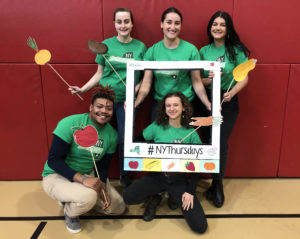What is tray waste?
Tray waste, as the name implies, is the amount of food waste left behind on a student’s tray at lunch or breakfast at school. In an effort to be more eco-friendly and conscientious, as well as to improve the nutrition standards of children in schools, periodic studies are conducted to measure how much waste is produced in the cafeteria. Each day, children are offered a full meal congruent with United States Department of Agriculture (USDA) standards to ensure their nutritional needs are met. It is up to the student, however, to eat everything served, meet nutritional goals, and keep their bodies and minds healthy. When children do not eat enough from one nutritional category, it not only affects their performance in school, but may even negatively impact their development.
At the Food and Health Network, we aim to combat this problem by observing what children are actually eating in school cafeterias. Two tray waste studies were conducted at Newark Valley Middle School to address the question, “What are children eating and what are they throwing away?” We set out to explore this question; the results were surprising and insightful.
Data Collection and Analysis
The first study was performed on NY Thursday, with southwest chicken chili as the main entrée being served. A month later, pizza was served as the main entrée. On both days, salad, turkey or ham and cheese sandwiches, peanut butter and jelly sandwiches, yogurt, snacks, and fresh fruit were also an option. After analysis of the data, we found that the students wasted more food when southwest chicken chili was menued, with some students naming large pieces of vegetables as the reason for the waste. When pizza, a cafeteria favorite, was served, it was wasted far less. For those who had salads, ham or turkey and cheese sandwiches, or peanut butter jelly sandwiches as an alternative, the waste was also minimal. Fresh fruit such as apples were placed in the share box (a communal food sharing box in the cafeteria) more often than not. Products like chocolate milk, juice drinks, packaged crackers, and muffins were consumed readily.
Based on evidence collected from the tray waste studies at Newark Valley Middle School, it was clear that students gravitated towards more processed items containing less fresh vegetables and fruit. As advocates of childhood nutrition, this raises concerns around high amounts of sugar and refined carbohydrates being consumed in place of healthy, filling ingredients such as fresh fruits and vegetables, legumes, and whole grains. Although Newark Valley had access to reusable plastic trays, they, like many school kitchens, do not have the full capacity to wash them all. As a result, the reusable trays are often substituted for styrofoam trays. This small change has a significant impact on waste. When washable trays are used, two bags of garbage are produced, whereas more than five bags of garbage are produced when using styrofoam, at this particular school.
Addressing the Problem
How can we encourage children to choose healthy, nourishing foods? How can we produce less waste to put in landfills? While the solution is not simple, there are steps community members and family members can take to improve these outcomes. Encourage children to eat healthy by educating them about the benefits of fruits and vegetables and expose them to such vegetables by offering healthy choices at a young age. Include children in the menu selection process and offer taste tests with fresh ingredients. Limit food waste by starting compost bins in schools, educate students on the environmental impact of waste, and limit other types of waste by allocating more school funds to kitchen staff and products, such as washable trays. Get involved as a community or family member by contacting your school district and local organizations to see how you can help. These changes are slight and incremental, and no systemic or profound changes will happen overnight but with engagement, support, and education, it is possible to improve the well-being of children by addressing tray waste and the reasoning behind it.
Figure 1: Tray waste on NY Thursday

Figure 2: Tray waste on pizza day


